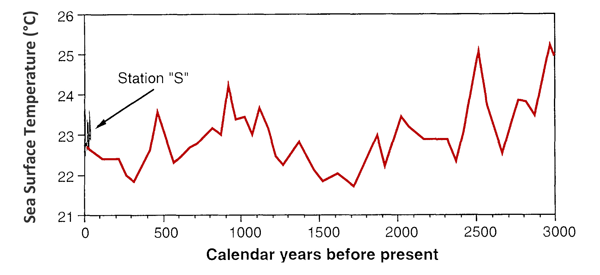Reference
Keigwin, L.D. 1996. The Little Ice Age and Medieval Warm Period in the Sargasso Sea. Science 274: 1504-1508.
Description
Working with two subcores of a Sargasso Sea sediment box core retrieved from 33°41.6'N, 57°36.7'W on the northeast Bermuda Rise, Keigwin measured the oxygen isotope ratios (δ18O) of the white variety of the planktonic foraminifera Globigerinoides ruber, which "lives year-round in the upper 25 meters of the northern Sargasso Sea and has a relatively constant annual mass flux and shell flux [to the ocean floor]." Plotting these ratios against temperature and salinity data that had been obtained at nearby Ocean Station "S" (32°N, 62°30'W) over the prior 42 years, he determined that "temperature accounts for about two-thirds of the isotopic signal, whereas salinity accounts for one-third." And based on these results, he calculated sea surface temperatures (SSTs) of the prior three millennia, after which he "stacked the temperature proxy data from the two subcores by averaging results in 50-year bins," obtaining the results depicted in the figure below, where it can be seen -- even using Mann's "Nature trick" of adding the most recent measured SSTs to the end of the reconstructed SST record -- that the peak temperature of the MWP was still approximately 0.7°C warmer than that of the CWP.

Fifty-year averages of mean annual sea surface temperature calculated from the δ18O data of the two Bermuda Rise sediment subcores, together with the mean annual SSTs measured at Ocean Station "S" over the period 1954-1996. Adapted from Keigwin (1996).




